.gif)
Villa Ehinger (Münchenstein)
Encyclopedia
The Villa Ehinger is in the Neue Welt
, a sub-district of Münchenstein
, in the canton
of Basel-Country
in Switzerland
.
waterfall in Münchenstein and from here the water is diverged.
 The Villa Ehinger is situated in the middle of a Park, above the industry. The neo-classical summer residence became renowned under the name of the ultimate owners. The Villa was originally built in association with the previous hammer mill (Hammerschmiede).
The Villa Ehinger is situated in the middle of a Park, above the industry. The neo-classical summer residence became renowned under the name of the ultimate owners. The Villa was originally built in association with the previous hammer mill (Hammerschmiede).
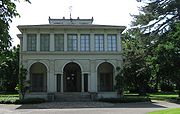 The hammer mill from 1660 is the oldest building situated on the banks of the canal. It was built by Ludwig Krug. During 1822 the hammer mill was refurbished as a cotton-spinning mill by Felix Sarasin (1771–1839). The technical administration was taken on by his son Ludwig August Sarasin (1804–31), who sought for his new residence to be built nearby.
The hammer mill from 1660 is the oldest building situated on the banks of the canal. It was built by Ludwig Krug. During 1822 the hammer mill was refurbished as a cotton-spinning mill by Felix Sarasin (1771–1839). The technical administration was taken on by his son Ludwig August Sarasin (1804–31), who sought for his new residence to be built nearby.
Sarasins acquaintance with the young architect Melchior Berri
initiate him to commission Berri with the planning and construction of this country house in 1829. Up until then Berris work had been confined by the existing frontages of the town streets (Basel Casino and other buildings with in the town). Here, however, he was free to build a house that was unconfined by other buildings or existing boundaries, a building that should have an English garden surrounding it. Unfortunately Ludwig August Sarasin died 1831, before the conclusion of the building, in 1932. One of the Sarasin daughters married into the Ehinger Family and that is how the villa came to its name.
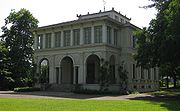
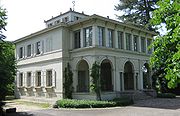 The family Ehinger sold the entire estate including the villa and its grounds to the municipality (Gemeinde) Münchenstein in 1959.
The family Ehinger sold the entire estate including the villa and its grounds to the municipality (Gemeinde) Münchenstein in 1959.
The municipality then passed the estate onto the canton Baselland in 1962. The canton built a grammar (secondary) school on the estate grounds in 1972.
In 1973 the villa was completely restored and refurbished as a Music School.
During the refurbishment, significant cultural consideration were paid to the initial Architecture. Special attention was given to ensure that each separate room was given a new function, without changing its individuality within the historical building.
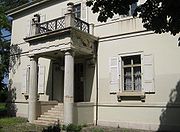
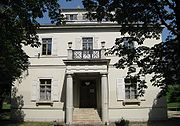 The villa has a virtually quadratic ground plan. It is a two-storey building. On the western side of the house there is a Portico
The villa has a virtually quadratic ground plan. It is a two-storey building. On the western side of the house there is a Portico
as entrance. Two Doric columns carry an entablature
and the balcony.
Built onto the eastern side of the villa (facing towards the park) there is also a two-storey Loggia
, but this is somewhat narrower. The semicircular arched foyer is one of the most significant features of this villa. This foyer/vestibule
can be assigned to the themes of Sebastiano Serlio
(1475–1554) and Andrea Palladio
(1508–1580). In the middle of the pyramidal broach roof is the Palmette
(also called anthemion) window storey. The crown is concluded with a roof pinnacle, a rod of Asclepius
, to emphasize the apex of the gable. There is a fountain on the southern side of the house that is typical for the epoch.
In the interior, the sections are aligned to the east-west axis. The rooms are grouped around the central Foyer. Not only Berris stucco ceilings, but also the neo-classical white stove on the first floor and the original drawings of the Portico remain conserved.
Neue Welt
The Neue Welt is a sub-district of Münchenstein, in the canton of Basel-Country in Switzerland.-Geographical location:The geographical area called the Neue Welt evolved in the 17th century as the industry started establishing itself around the upper end of the "St. Alban-Teich". This is a canal,...
, a sub-district of Münchenstein
Münchenstein
Münchenstein is a municipality in the district of Arlesheim in the canton of Basel-Landschaft in Switzerland.-Historical records:Münchenstein is first mentioned in 1196 as Kekingen. In 1270 it was mentioned as Geckingen and in 1279 as Munchenstein.* 1259: The hamlet and the mill, between "Neue...
, in the canton
Cantons of Switzerland
The 26 cantons of Switzerland are the member states of the federal state of Switzerland. Each canton was a fully sovereign state with its own borders, army and currency from the Treaty of Westphalia until the establishment of the Swiss federal state in 1848...
of Basel-Country
Basel-Country
Basel-Landschaft , is one of the 26 cantons of Switzerland. The capital is Liestal...
in Switzerland
Switzerland
Switzerland name of one of the Swiss cantons. ; ; ; or ), in its full name the Swiss Confederation , is a federal republic consisting of 26 cantons, with Bern as the seat of the federal authorities. The country is situated in Western Europe,Or Central Europe depending on the definition....
.
Geographical location
The geographical area called the Neue Welt (new world) evolved as the industry started establishing itself around the upper end of the "St. Alban-Teich". This is a canal, artificially constructed by the Basler Kloster St. Alban during the 12th century, so as to bring water and water power to the industry in Basel. Later, during the years 1624/25, the canal was prolonged through Brüglingen towards the BirsBirs
The Birs is a 73-km long river in Switzerland that flows through the Jura region and ends as a tributary to the Rhine between Basel and Birsfelden.- Picture gallery :...
waterfall in Münchenstein and from here the water is diverged.
History


Sarasins acquaintance with the young architect Melchior Berri
Melchior Berri
Melchior Berri was a well-known Swiss architect.He was the son of Melchior Berri and Appollonia Streckeisen. In 1832 he married Margaretha Simone Burckhardt of Basel....
initiate him to commission Berri with the planning and construction of this country house in 1829. Up until then Berris work had been confined by the existing frontages of the town streets (Basel Casino and other buildings with in the town). Here, however, he was free to build a house that was unconfined by other buildings or existing boundaries, a building that should have an English garden surrounding it. Unfortunately Ludwig August Sarasin died 1831, before the conclusion of the building, in 1932. One of the Sarasin daughters married into the Ehinger Family and that is how the villa came to its name.
Modern-day History


The municipality then passed the estate onto the canton Baselland in 1962. The canton built a grammar (secondary) school on the estate grounds in 1972.
In 1973 the villa was completely restored and refurbished as a Music School.
During the refurbishment, significant cultural consideration were paid to the initial Architecture. Special attention was given to ensure that each separate room was given a new function, without changing its individuality within the historical building.
Architecture


Portico
A portico is a porch leading to the entrance of a building, or extended as a colonnade, with a roof structure over a walkway, supported by columns or enclosed by walls...
as entrance. Two Doric columns carry an entablature
Entablature
An entablature refers to the superstructure of moldings and bands which lie horizontally above columns, resting on their capitals. Entablatures are major elements of classical architecture, and are commonly divided into the architrave , the frieze ,...
and the balcony.
Built onto the eastern side of the villa (facing towards the park) there is also a two-storey Loggia
Loggia
Loggia is the name given to an architectural feature, originally of Minoan design. They are often a gallery or corridor at ground level, sometimes higher, on the facade of a building and open to the air on one side, where it is supported by columns or pierced openings in the wall...
, but this is somewhat narrower. The semicircular arched foyer is one of the most significant features of this villa. This foyer/vestibule
Vestibule (architecture)
A vestibule is a lobby, entrance hall, or passage between the entrance and the interior of a building.The same term can apply to structures in modern or ancient roman architecture. In modern architecture vestibule typically refers to a small room or hall between an entrance and the interior of...
can be assigned to the themes of Sebastiano Serlio
Sebastiano Serlio
Sebastiano Serlio was an Italian Mannerist architect, who was part of the Italian team building the Palace of Fontainebleau...
(1475–1554) and Andrea Palladio
Andrea Palladio
Andrea Palladio was an architect active in the Republic of Venice. Palladio, influenced by Roman and Greek architecture, primarily by Vitruvius, is widely considered the most influential individual in the history of Western architecture...
(1508–1580). In the middle of the pyramidal broach roof is the Palmette
Palmette
The palmette is a motif in decorative art which, in its most characteristic expression, resembles the fan-shaped leaves of a palm tree. It has an extremely long history, originating in Ancient Egypt with a subsequent development through the art of most of Eurasia, often in forms that bear...
(also called anthemion) window storey. The crown is concluded with a roof pinnacle, a rod of Asclepius
Rod of Asclepius
The rod of Asclepius , also known as the asklepian, is an ancient symbol associated with astrology, the Greek god Asclepius, and with medicine and healing. It consists of a serpent entwined around a staff. The name of the symbol derives from its early and widespread association with Asclepius, the...
, to emphasize the apex of the gable. There is a fountain on the southern side of the house that is typical for the epoch.
In the interior, the sections are aligned to the east-west axis. The rooms are grouped around the central Foyer. Not only Berris stucco ceilings, but also the neo-classical white stove on the first floor and the original drawings of the Portico remain conserved.

